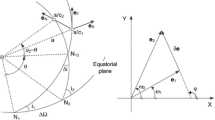Abstract
A set of parameters called relative orbital elements were defined to describe the relative motion of the satellites in the formation flying. With the help of these parameters, the effect of the perturbations on the relative orbit trajectory and geometric properties of satellite formation can be easily analyzed. First, the relative orbital elements are derived, and pointed out: if the eccentricity of the leading satellite is a small value, the relative orbit trajectory is determined by the intersection between an elliptic cylinder and a plane in the leading satellite orbit frame reference; and the parameters that describe the elliptic cylinder and the plane can be used to obtain the relative orbit trajectory and the relative orbital elements. Second, by analyzing the effects of gravitational perturbations on the relative orbit using the relative orbital elements, it is found that the propagation of a relative orbit consists of two parts: one is the drift of the elliptic cylinder; and the other is the rotation of the plane resulted from the rotation of the normal of the plane. Meanwhile, the analytic formulae for the drift and rotation rates of a relative trajectory under gravitational perturbations are presented. Finally, the relative orbit trajectory and the corresponding changes were analyzed with respect to the J2 perturbation.
Similar content being viewed by others
Abbreviations
- OXYZ:
-
Earth’s equatorial inertial reference frame
- Sl xyz:
-
Leading satellite orbit frame
- Sf xyz:
-
Following satellite orbit frame
- ω:
-
Argument of perigee
- M:
-
Mean anomaly
- f:
-
True anomaly
- a:
-
Semi-major axis
- e:
-
Eccentricity
- i:
-
Orbit inclination
- Ω:
-
Right ascension of the ascending node
- θ=ω+f:
-
Argument of latitude
- n:
-
Mean motion
- r:
-
Satellite position vector
- x,y,z:
-
Relative displacements in leading satellite orbit frame
References
Clohessy W H, Wiltshire R S. Terminal guidance system for satellite rendezvous [J]. Journal of the Aerospace Science, 1960,27 (5): 653–658,674.
Karlgaard C D, Lutze F H. Second-order relative motion equation [J]. Journal of Guidance, Control, and Dynamics,2003,27 (1):499–501.
Schweighart S A, Sedwick R J. High-fidelity linearized J 2 model for satellite formation flight [J]. Journal of Guidance, Control, and Dynamics, 2002,25 (6):1073–1080.
Vaddi S S, Vadali S R, Alfriend K T. Formation flying: accommodating nonlinearity and eccentricity perturbations [J]. Journal of Guidance, Control, and Dynamics, 2003, 26 (2): 214–223.
Sedwick R J, Miller D W, Kong EMC. Mitigation of differential perturbations in clusters of formation flying satellites[R]. AAS/AIAA Space Flight Mechanics Meeting, American Astronautical Society, AAS Paper, Feb, 1999,99–124.
Baoyin H, Li Junfeng, Gao Yunfeng. Dynamical behaviors and relative trajectories of spacecrafts formation flying [J]. Journal of Aerospace Science and Technology,2002,4 (6):295–301.
Inalhan G, Tillerson M, How J P. Relative dynamics and control of spacecraft formations in eccentric orbits [J]. Journal of Guidance, Control, and Dynamics, 2002, 25 (1): 48–59.
Melton R G. Time explicit representation of relative motion between elliptical orbits [J]. Journal of Guidance, Control, and Dynamics, 2000, 23 (4): 604–610.
Li Junfeng, Gao Yunfeng, Baoyin Uexi, et al. Study on satellite formation flying dynamics and control[J]. Mechanics in engineering, 2002, 24 (2):1–7 (in Chinese).
Gao Yunfeng, Baoyin Hexi, Li Junfeng. Dynamics behavior and simulation of relative config-urations of satellite formation flying [J]. Journal of Tsinghua University (Science and Technology), 2002, 42 (4); 458–461 (in Chinese).
Meng Xin, Li Junfeng, Gao Yunfeng. J 2 invariant perturbation conditions for the relative movement for satellites in formation flying[J]. Journal of Tsinghua University (Science and Technology), 2004, 44 (2): 219–223 (in Chinese).
Li Junfeng, Meng Xin, Gao Yunfeng,et al. Study on relative orbital configuration in satellite formation flying[J]. Acta Mechanica Sinica, 2005, 21 (1); 87–94.
Zhang Renwei. Orbit and Attitude Dynamics and Control of Satellite [M]. Beijing Univ Aeronautics and Astronautics Press, Beijing, 1998 (in Chinese).
Li Junfeng, Meng Xin, Gao Yunfeng, et al. J 2 perturbation effect on relative orbital configuration of satellites in formation flying[J]. Journal of Tsinghua University (Science and Technology), 2004, 44 (2): 224–227, 251 (in Chinese).
Author information
Authors and Affiliations
Additional information
Communicated by MA Xing-rui
Project supported by the National Natural Science Foundation of China (No. 10202008); the Specialized Research Found for the Doctoral Programs of Higher Education ( No. 20020003024)
Rights and permissions
About this article
Cite this article
Meng, X., Li, Jf. & Gao, Yf. Useful relative motion description method for Perturbations analysis in satellite Formation flying. Appl. Math. Mech.-Engl. Ed. 26, 1464–1474 (2005). https://doi.org/10.1007/BF03246253
Received:
Revised:
Issue Date:
DOI: https://doi.org/10.1007/BF03246253




